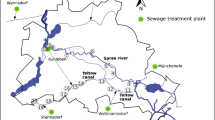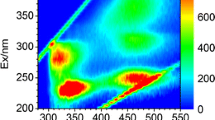Abstract
The presence of fecal coliform bacteria in many watersheds is often linked to septic system effluent. Fluorescent whitening agents (FWA) are part of most laundry detergent formulations and previously have been used for fingerprinting anthropogenic sewage waters. This study was carried out to investigate the fate of FWA in spring water downstream from a well-monitored septic system in a small forest watershed. Samples for FWA were collected at the spring and along the flow path downstream and analyzed fluorometrically. Selected sampling events were scheduled at night and daytime and after rainstorms to investigate possible changes in the spring water composition. In addition, reference fluorescence spectra were prepared for humic and tannic acid and for the laundry detergent used exclusively in the household discharging into the test septic system. The results indicate that FWA can be detected in spring water, but interference with increasing humic acid concentration downstream limits the fingerprinting value of the method to the vicinity of the spring. Also, sampling for FWA after rainstorms only yielded results if at least 4 days had passed. Otherwise, dissolved organic substances transported into the spring water interfered with the FWA spectrum. No significant differences between night and daytime sampling were found. Overall, the method, as used at this study site, is of limited value for fingerprinting FWA in natural waters.






Similar content being viewed by others
References
Burg AW, Rohovsky MW, Kensler CJ (1977) Current status of human safety and environmental aspects of fluorescence whitening agents used in detergent in the United States. Crit Rev Environ Contrib 7:91–120
Carlson RE, Shapiro J (1981) Dissolved humic substances: a major source of error in fluorometric analyses involving lake waters. Limnol Oceanol 26:785–790
Eaton AD, Clesceri LS, Greenberg AE (eds) (1995) Standard methods for the examination of water and wastewater, 19th edn. Published jointly by American Public Health Association, American Water Works Association, Water Environment Federation. United Book Press, Maryland
Fay SR, Spong RC, Alexander SC, Alexander EC (1995) Optical brighteners: sorption behavior, detection, septic system tracer application. Proceedings of the International Association of Hydrology. XXVI International congress, Edmonton, Alberta, June 1995, Publ. MOW-TECH, Edmonton
Kramer JB (1992) Anthropogenic compounds, detergents. In: Hutzinger O (ed) The handbook of environmental chemistry, vol 3, F. Springer, Berlin, Heidelberg New York, pp 351–366
Malcolm RL (1985) Geochemistry of stream fulvic and humic substances. In: Aiken GR, McKnight DM, Wershaw RL, MacCarthy P (eds) Humic substances in soil, sediment, and water. Wiley, New York
Sargeant D (1999) Fecal contamination source identification methods in surface water. Ecology Report #99-345, Dept. of Ecology, Washington State University, Pullman
Sargeant D, Castonguay W (1998) An optical brightener handbook. In: http://www.naturecompass.org/8tb/sampling/index.html
Smart PL, Laidlaw IMS (1977) An evaluation of some fluorescent dyes for water tracing. Water Resour Res 13(1):15–33
Spong RC, Steffan RF, Alexander EC (1995) Optical brightener screening for sewage contamination of water table aquifers in southeastern Minnesota, USA. Proceedings of the International Association of Hydrology. XXVI, International Congress, Edmonton, Alberta. June 1995. MOW-TECH, Edmonton
Stoll JMA, Giger W (1998) Mass balance for detergent-derived fluorescent whitening agents in surface waters of Switzerland. Water Res 32(7):2041–2050
Stoll JMA, Poiger TF, Lotter AF, Sturm M, Giger W (1997) Fluorescent whitening agents as molecular markers for domestic waste water in recent sediments of Greifensee, Switzerland. In: Eganhouse RP (ed) Molecular markers in environmental geochemistry. ACS Symposium Series 671, American Chemical Society, Washington, DC, pp 231–241
Acknowledgement
Funding was provided by the Rhode Island Agricultural Experiment Station, College of the Environment and Life Sciences, University of Rhode Island.
Author information
Authors and Affiliations
Corresponding author
Rights and permissions
About this article
Cite this article
Boving, T.B., Meritt, D.L. & Boothroyd, J.C. Fingerprinting sources of bacterial input into small residential watersheds: fate of fluorescent whitening agents. Env Geol 46, 228–232 (2004). https://doi.org/10.1007/s00254-004-0988-1
Received:
Accepted:
Published:
Issue Date:
DOI: https://doi.org/10.1007/s00254-004-0988-1




